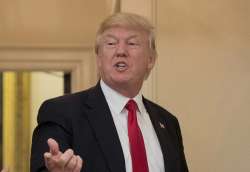US exports to India continue facing barriers: Trump administration
US exports to India continue to face barriers as Indian customs officials generally require extensive documentation, leading to frequent and lengthy processing delays, Trump administration has alleged.

US exports to India continue to face barriers as Indian customs officials generally require extensive documentation, leading to frequent and lengthy processing delays, the Trump administration has alleged.
Despite the Indian government's efforts to pursue economic reforms, the structure of India's customs tariff and fees system are "complex and characterised by a lack of transparency" in determining net effective rates of customs tariffs, excise duties, and other duties and charges, the US Trade Representative (USTR) said it its annual report.
Noting that US exporters have raised concerns regarding India's application of customs valuation criteria to import transactions, it said India's customs officials generally require extensive documentation, inhibiting the free flow of trade and leading to frequent and lengthy processing delays.
This is a consequence of India's complex tariff structure, including the provision of multiple exemptions, which vary according to product, user, or intended use, it said.
India, the report said, lacks an overarching government procurement policy and, as a result, its government procurement practices and procedures vary among the states, between the states and the central government, and among different ministries within the central government.
In its annual 2017 National Trade Estimate, the first under US President Donald Trump, the US goods and trade deficit with India was USD 24.3 billion, a 4.2 per cent increase (USD 970 million) last year, the USTR said.
The report came hours before Trump was expected to sign an executive order instructing his administration to examine the cause of trade imbalances with over 15 countries, including China and India.
According to the report, US goods exports to India were USD 21.7 billion, up 1.1 per cent (USD 237 million) from the previous year. Corresponding US imports from India were USD 46.0 billion, up 2.7 per cent.
India was the US' 18th largest goods export market last year, the report said.
On the other hand, US exports of services to India were an estimated USD 18.1 billion in 2015 (latest data available) and US imports were USD 24.7 billion.
Sales of services in India by majority US-owned affiliates were USD 22.7 billion in 2014 (latest data available), while sales of services in the US by majority India-owned firms were USD 13.4 billion, it said.
Further, the US Foreign Direct Investment (FDI) in India (stock) was USD 28.3 billion in 2015 (latest data available), a 4.4 per cent increase from 2014. The US FDI in India is led by professional, scientific, and technical services, manufacturing, and wholesale trade, USTR said.
Taking note of the national Goods and Services Tax (GST), the report said it would replace most indirect taxes, including various charges on imports.
The GST is designed to simplify the movement of goods within India, it said.
In 2015, the Indian government introduced the GST Bill in Parliament and it was passed in July last year. India is working on the implementation of the GST law, which would put in place a two-part system.
The first part of the system are the State and Central GST that will be levied simultaneously on every transaction of goods and services within a state. The second part is an "integrated GST" that covers goods and services sold between all Indian states. The integrated GST would apply to imports.
India intends to implement GST by July, the report said.